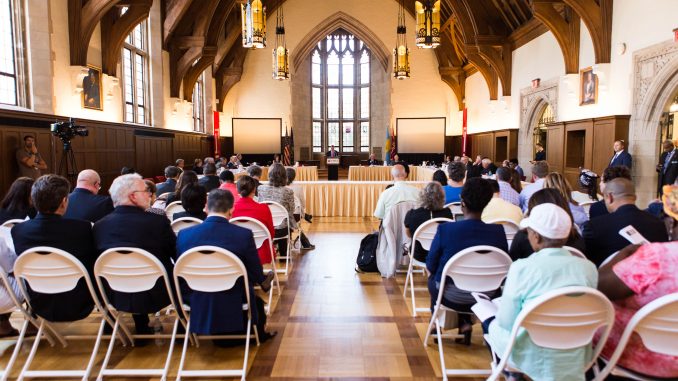
The university is hoping to complete its $1.25-million feasibility study for an on-campus stadium by the end of the calendar year, said trustee and Athletics Committee Chair J. William Mills III after Tuesday’s Board of Trustees meeting.
President Richard Englert echoed his remarks from his State of the University Address last month to trustees in his President’s Report Tuesday that the university is still pursuing the possibility of an on-campus facility.
The university would want the $130-million multipurpose facility with classrooms, retail space and a 35,000-seat stadium to have “benefits for our neighbors as well as the university,” Englert said.
A university spokesperson told The Temple News on Tuesday that Ohio-based architecture firm Moody Nolan completed its portion of the feasibility study, but there are multiple ongoing studies being conducted by the university.
Read The Temple News’ breakdown of everything about the stadium so far.These studies are separate from the feasibility study and look at options for parking, traffic and any other issue that arises, the spokesperson said.
A Moody Nolan representative told The Temple News in February its study was “on hold.”
“We’re continuing to look at every element of it from the cost, from the feasibility, from its ramifications to the neighborhood and everything,” Mills said. “We’re doing everything at this point. …When we talk about a large project, you’ve gotta do all those kinds of things to make sure that we make the right decision.”
Mills said the university “would probably decide to get a stadium district” where people paid by the university would keep the surrounding blocks clean and safe throughout the year.
The Sports Complex Special Services District serves about 9,000 residents who live in an area bounded by 20th Street, Oregon Avenue, 7th Street and Interstate-95 near the Philadelphia Sports Complex — the home of the Eagles, Flyers, 76ers and Phillies.
The 9,000 residents live in four different districts in the vicinity of the complex. The closest zone, District I, has a stadium parking lot across the street from its eastern boundary of 13th Street.
The district addresses the community’s concerns with street and sidewalk cleaning, traffic and parking. The Executive Board is made up of elected community representatives, state and city officials and sports venue executives, according to its website.
Mills said that “there’s nothing set yet,” but the plan would be to start construction underground to keep the stadium at a low height to reduce noise and make it “less intrusive on the neighborhood.” It would likely be lower in height than the Liacouras Center, or about two or three stories tall, he said.
The University of South Florida, which also plays football in the American Athletic Conference, released a 41-page, $75,000 feasibility study investigating the possibility of a 40,000-50,000-seat, on-campus stadium in August. The projected cost for South Florida’s facility, which is in the early stages of planning, is more than $200 million.
More comparable universities in urban settings, however, are the University of Cincinnati and Tulane University, which both compete in The American, Mills said. Tulane’s 30,000-seat stadium opened at a cost of $75 million in 2014.
“We’re looking at this thing, we’re trying to be very fiscally responsible,” Mills said.


Be the first to comment